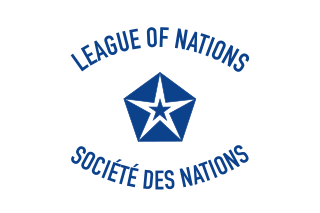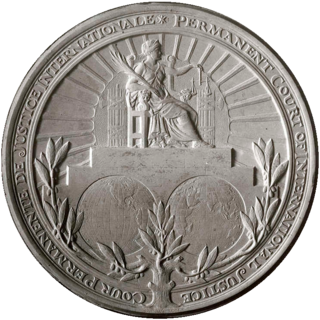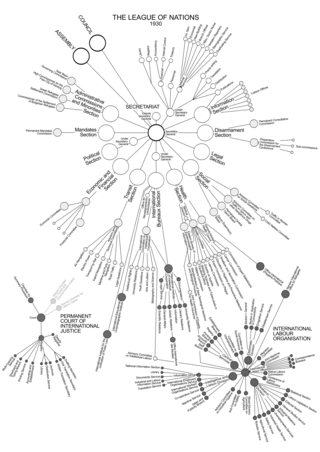Clauses
The statute consisted of 64 articles. [2]
Article 1 stated that the Court is established in conformity with article 14 of the Covenant of the League of Nations, and its function shall not contradict the operation of the Permanent Court of Arbitration or any other special arbitration tribunals.
Article 2 stipulated that the Court shall consist of independent judges, elected regardless of nationality.
Article 3 fixed the number of judges at 11, plus 4 deputy-judges.
Article 4 provided for election of judges by the League Assembly and Council from lists of candidates delivered by the candidates' national governments.

The International Court of Justice is the only international court that adjudicates general disputes between nations, and gives advisory opinions on international legal issues. It is one of the six organs of the United Nations (UN), and is located in The Hague, Netherlands.

The League of Nations was the first worldwide intergovernmental organisation whose principal mission was to maintain world peace. It was founded on 10 January 1920 by the Paris Peace Conference that ended the First World War. The main organization ceased operations on 18 April 1946 when many of its components were relocated into the new United Nations. As the template for modern global governance, the League profoundly shaped the modern world.

The Permanent Court of International Justice, often called the World Court, existed from 1922 to 1946. It was an international court attached to the League of Nations. Created in 1920, the Court was initially well-received from states and academics alike, with many cases submitted to it for its first decade of operation.
The International law bearing on issues of Arab–Israeli conflict, which became a major arena of regional and international tension since the birth of Israel in 1948, resulting in several disputes between a number of Arab countries and Israel.
A treaty series is an officially published collection of treaties and other international agreements.

The Statute of the International Court of Justice is an integral part of the United Nations Charter, as specified by Chapter XIV of the United Nations Charter, which established the International Court of Justice.

The Minority Treaties[a] are treaties, League of Nations mandates, and unilateral declarations made by countries applying for membership in the League of Nations that conferred basic rights on all the inhabitants of the country without distinction of birth, nationality, language, race or religion. The country concerned had to acknowledge the clauses of the treaty as fundamental laws of state and as obligations of international concern placed under the guarantee of the League of Nations. Most of the treaties entered into force after the Paris Peace Conference.
A peace congress, in international relations, has at times been defined in a way that would distinguish it from a peace conference, as an ambitious forum to carry out dispute resolution in international affairs, and prevent wars. This idea was widely promoted during the nineteenth century, anticipating the international bodies that would be set up in the twentieth century with comparable aims.

The League of Nations was established with three main constitutional organs: the Assembly; the Council; the Permanent Secretariat. The two essential wings of the League were the Permanent Court of International Justice and the International Labour Organization.
An agreement concluded between the British and Danish governments in Copenhagen on 14 July 1921, in order to regulate legal relations between Danish citizens and the court system in Egypt. Ratifications were not exchanged for this agreement, since that was not required by its provisions, and the agreement went into effect. It was registered in the League of Nations Treaty Series on 20 August 1921.
The Barcelona Convention and Statute on Freedom of Transit is an International treaty signed in Barcelona on 20 April 1921; the treaty ensures freedom of transit for various commercial goods across national boundaries. It was registered in League of Nations Treaty Series on 8 October 1921. It went into effect on 31 October 1922. The convention is still in force at present.
The Barcelona Convention and Statute on the Regime of Navigable Waterways of International Concern is a multilateral treaty that was concluded at Barcelona on 20 April 1921. Its purpose is to ensure freedom of navigation in waterways which bear international significance. It was registered in League of Nations Treaty Series on 8 October 1921. It went into effect on 31 October 1922. The convention is still in force.
The Agreement between Great Britain and Portugal Relating to the Suppression of the Capitulations in Egypt (1920) was an agreement concluded between the British and Portuguese governments in Lisbon on 9 December 1920, in order to regulate legal relations between Portuguese citizens and the court system in Egypt. Ratifications were exchanged in Lisbon on 29 September 1921 and the agreement went into effect. It was registered in the League of Nations Treaty Series on 12 December 1921.
The General Act for the Pacific Settlement of International Disputes is a multilateral convention concluded in Geneva on September 26, 1928. It went into effect on August 16, 1929 and was registered in League of Nations Treaty Series on the same day. The treaty was ultimately ratified by 22 states. It was subsequently denounced by Spain.
The 2011 International Court of Justice election began on 10 November 2011 at United Nations Headquarters in New York City. In the set of triennial elections, the General Assembly and the Security Council concurrently elect five judges to the Court for nine-year terms, in this case beginning on 6 February 2012. From the eight candidates, the five winners were Giorgio Gaja (Italy), Hisashi Owada (Japan), Peter Tomka (Slovakia), Xue Hanqin (China) and Julia Sebutinde (Uganda).
The 2014 International Court of Justice election began on 6 November 2014 at United Nations Headquarters in New York City. In the set of triennial elections, the General Assembly and the Security Council concurrently elect five judges to the Court for nine-year terms, in this case beginning on 6 February 2015.
The 2017 International Court of Justice election took place from 9 to 20 November 2017 at the United Nations Headquarters in New York City. In the set of triennial elections, the General Assembly and the Security Council concurrently elect five judges to the Court for nine-year terms, in this case beginning on 6 February 2018. From the seven candidates, the five winners were Abdulqawi Yusuf (Somalia), Antônio Augusto Cançado Trindade (Brazil), Nawaf Salam (Lebanon), Ronny Abraham (France) and Dalveer Bhandari (India).
The 2020 International Court of Justice election were held on 11 and 12 November 2020 at the United Nations Headquarters in New York City. In the set of triennial elections, the General Assembly and the Security Council concurrently elect five judges to the Court for nine-year terms, in this case beginning on 6 February 2021. From the eight candidates, Yuji Iwasawa (Japan), Xue Hanqin (China), Peter Tomka (Slovakia), Julia Sebutinde (Uganda), and Georg Nolte (Germany) have been elected members of the International Court of Justice for a term of office of nine years, as both the Security Council and the General Assembly have agreed on the same candidates.
The 2022 International Court of Justice election was held on 4 November 2022 at the United Nations Headquarters in New York City. The General Assembly and the Security Council concurrently elected Leonardo Nemer Caldeira Brant for remainder of the nine-year term of office that had been held by Judge Antônio Cançado Trindade, who died in May, 2022.
The 2023 International Court of Justice election was held on 9 November 2023 at the United Nations Headquarters in New York City. In the set of triennial elections, the General Assembly and the Security Council concurrently elect five judges to the Court for nine-year terms.




